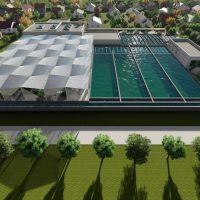Organica FCR
Solution if Brief
The Solution
Organica is the world leader in Fixed-Bed Activated Sludge (FBAS) technology. FBAS leverages the use of various natural and engineered media to provide a fixed habitat for a diverse fixed-film bacterial culture which metabolizes the contaminants in wastewater. These populations of organisms live in an attached form on fixed bed media inside the reactors, as opposed to being in constant motion as is the case with conventional technologies such as Activated Sludge or MBBR. Providing a stationary habitat allows an incredibly diverse and robust biofilm to grow and thrive inside the reactors, ultimately offering significantly improved nutrient removal, energy efficiency, and resiliency, all in much less space than conventional technologies. Organica’s Food-Chain-Reactor (FCR) represents the best-of-breed in FBAS wastewater treatment plants. The FCR is a complete wastewater treatment solution incorporated into a compact, single structure.
Organica Treatment Plant
The complete system; from solids removal, biological treatment, phase separation, and final treatment to reuse quality fits inside an attractive structure which in itself provides a space for passive enjoyment in a garden-like setting.
Enclosure
Be it glass, membrane, or an attractive shading structure, a decentralized wastewater solution must have a sense of containment from its surroundings while protecting the garden within.
Pretreatment
Solids removal can be coupled with other options depending on the influent quality.
Reactor Cascade
The wastewater flows through a series of reactors that are configured and operated to allow the development of distinct ecosystems arranged to form a complex network.
Final Treatment
Polishing, disinfection depending on local regulatory standards.
Phase Separation
Very low TSS in the last reactor allows discf ilters to be used for phase separation.
The Biomodule
This is the basic unit of the Organica Solution. Conditions are created to promote the consumption of contaminants by thousands of species of organisms living within the root zone and the engineered media.
Aquatic Plants
Important from a technological viewpoint in providing an ideal fixed film substrate, plants uniquely enhance aesthetics with little additional maintenance.
Engineered Media
A patented woven textile which provides a place for organisms to attach and thrive.
Diffused Aeration
Traditional fine bubble aeration used for aerobic phases.
Root System
Provides an ideal habitat for organisms to live. After establishing in the root zone, species thrive not only on the waste stream, but benefit from symbiotic relationships with the plant roots.
Unique Look and Feel
Far from being a set of unpleasant concrete structures, the Organica treatment plants are visually pleasing and odor-free. Because they enhance their surroundings, the sustainable designs can be easily located close to the wastewater source, making water reuse feasible.
The solution is very flexible in terms of size, spanning a wide range of capacities. Additionally, the solution can easily be applied to the upgrade market adding capacity and efficiency to existing treatment facilities.
The Benefits
Organica Solution ensures:
- Better treatment characteristics and high water quality;
- No impact on real estate values;
- Pleasing and odor-free environment;
- Lower energy consumption;
- Cost Savings in operations and in overall footprint;
- Competitive investment costs.
Energy Savings
The cooperation of complex living systems, small footprint, proximity to wastewater source all contribute to siginificant energy savings.
Cleaner Water
Research is showing that the broader and more complex ecology is able to break down a wider range of emerging pollutants of concern such as medicines and other xenobiotics with higher efficiency.
Easy Operation
The intelligent process control allows for very flexible and highly automated low-cost operation. The plants are designed for trouble-free maintenance and manageability.
Footprint Savings
Highly intensified biology and compact, architectural designs make the footprint of Organica facilities up to 40% smaller than any state-of-the-art technology and significantly smaller than conventional activated sludge plants.
Convergence Of Disciplines
The treatment plants are places where advanced ecological sciences and biotechnology meet hard core engineering and information technologies; this intersection of innovation delivers breakthrough advances in performance, cost, footprint and aesthetics.
Applications
The solution is very flexible in terms of size, spanning a wide range of capacities. Additionally, the Organica Solution can easily be applied to the upgrade market adding capacity and efficiency to existing treatment facilities.
Municipal
Attractive architectural solutions make possible seamless integration into the urban landscape greatly facilitating water reuse. A wide range of capacities can be implemented depending on the need and available footprint.
Industrial
The solution easily fits into any industrial campus for on-site water recycling; an appropriate solution for any biodegradable waste stream, for example, food and beverage industries. Other treatment technologies can be easily integrated if necessary.
Upgrade
In the past 100 years, only 150000 WWTPs have been built globally. Organica’s upgrade capabilities can transform aging and obsolete infrastructure to reflect modern needs without replacing the existing facility.
Commercial
The solution is ideal for any place where people gather: airports, rest stops, schools, shopping malls, etc.; and provides onsite recycling of water for irrigation, cooling towers, toilets or any other non-potable use.

